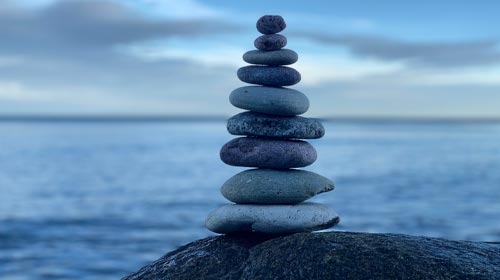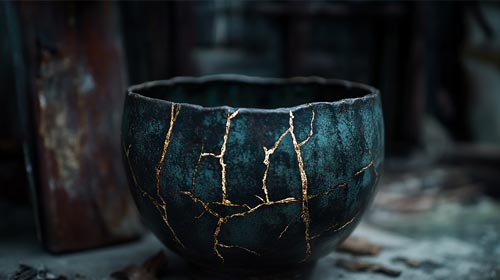What remains when everything unnecessary disappears? Zen answers this question not with words, but with experience. No concept, no ideology – Zen is presence. Pure experience. In the moment. Nothing obscured, nothing added. This is precisely why Zen is such a natural fit with tea. Especially in Japanese culture, the two are inextricably linked. A quiet spirit is reflected in the cup of tea.
Zen – origin and meaning
Zen developed from Chinese Chan Buddhism and arrived in Japan in the 12th century, where it was continued primarily in the Rinzai, Soto, and Obaku schools. The focus is not on teaching as theory, but on direct, personal experience—through meditation, concentration, and simple everyday actions.
Zen is not a religion in the dogmatic sense, but rather an attitude. Clarity, emptiness, reduction, and mindfulness permeate thought and action – even in the design of gardens, architecture, calligraphy, and tea.
How Zen shaped the Japanese tea path
The connection between tea and Zen did not begin in the monastery, but rather with individuals who combined tea and Zen in their everyday lives. One of these was Murata Jukō (1422–1502) . He was not a monk, but a tea master with a deep interest in Zen Buddhism. Influenced by the radical Rinzai monk Ikkyu Sojun , Jukō developed a new approach to tea drinking—calm, modest, and unpretentious.
He turned away from the luxurious style of the Chinese-influenced tea culture of the time and sought a simpler, more introspective form. This gave rise to what is known as Wabi-cha —an early form of tea aesthetic characterized by restraint, irregularity, and spiritual depth.
Later, Sen no Rikyū , Japan's most famous tea master, took up this tradition and developed it into a complete ritual: the Way of Tea ( Chadō ). Its principles—harmony (Wa), respect (Kei), purity (Sei), and stillness (Jaku)—are still characterized by the Zen spirit today.
Zazen and tea – two paths, one mind
Zazen, silent sitting meditation, is the heart of Zen. It demands nothing. It offers nothing. Only pure being. The tea ceremony can be experienced in the same way: as meditation in motion. The host prepares, the guest receives – wordlessly, attentively, consciously.
In some Zen monasteries, drinking tea is part of daily practice. The process is clearly structured, but never rigid. The tools are simple, often made of wood, clay, or bamboo. Tea is not consumed—it is experienced.
This form of mindfulness can also arise in everyday life. A cup of tea in the morning, prepared in silence, can become an anchor. No goal, no outcome—just the moment.
Matcha as a Zen experience
Matcha is not just tea, but a process. From planting to shading to fine grinding, it is produced with great care. Even the preparation – sifting the powder, pouring water, beating it into a figure-eight with the chasen – is characterized by inner calm.
Zen doesn't demand perfection. The foam may be uneven. The bowl may have cracks. All that matters is your presence. Matcha tastes green, tart, and concentrated. It challenges you, and that's precisely what makes it a training ground. It demands your senses—not your opinion.
Zen at Growing Karma – returning to the essence with tea
At Growing Karma, the focus is not on the product, but on the relationship: with the plant, the place, the season. Our tea plants grow slowly, adapted to the climate, embedded in permaculture. No fertilizers, no pressure – just patience, care, and observation.
This process is strongly reminiscent of Zen: nothing rushed, nothing forced. We harvest by hand, process gently, and treat each leaf with respect. Even the preparation—whether as green leaf tea or matcha—is an invitation to pause.
When you plant one of our plants in your garden, a new path begins for you, too. You'll learn to wait, observe, and marvel. And perhaps you'll discover more than just flavor in your next cup of tea.
Zen in everyday life – with tea as an approach
Zen isn't loud, it's not spectacular. It doesn't require any external conditions. You can start with a small cup of tea. Take your time. Sit quietly. Drink slowly. When you hear the breath, see the steam, feel the taste – you're already in the middle of it.
Even without a full ceremony, every sip of tea can become a Zen exercise. What matters is not the technique, but your attitude. Mindfulness instead of distraction. Simplicity instead of excess.
FAQ: Zen & Tea
What does Zen mean in the context of tea?
Zen brings mindfulness, presence, and reduction to tea culture. Tea is seen as a path to inner contemplation.
How is Zen expressed in the tea ceremony?
In a clear form, a calm process, simple utensils – and in the conscious experience of each step.
Was Murata Jukō a Zen monk?
No, but he was deeply influenced by Zen Buddhism. His teacher was the Rinzai monk Ikkyu Sojun.
Can you practice Zen in everyday life?
Yes – through conscious actions, such as mindfully preparing and drinking a cup of tea.
Zen is not a destination. It is a space that arises when you become still. Perhaps your path there begins with hot water, ground tea, and a bowl in your hand.




Leave a comment
This site is protected by hCaptcha and the hCaptcha Privacy Policy and Terms of Service apply.